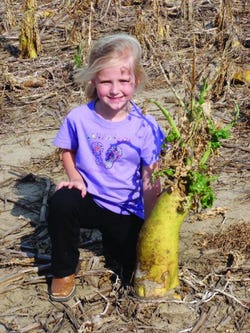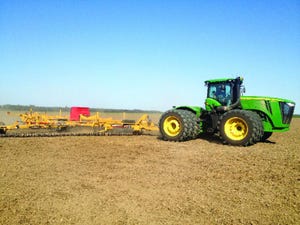
A “cocktail mix” of winter cover comprised of tillage radishes — which can send a tuber as much as 60 inches into the soil —cereal rye, and rape/canola help Mike Taylor and his son, Mikey, prevent erosion and wind damage on their 6,500-acre Long Lake Plantation near Helena, Ark.

Winter soil erosion and blowing spring dust storms that further depleted soils and damaged young crop plants led Mike Taylor 20 years ago to start a program of cover crops on his Arkansas farm.
Today he and son Mikey, whose 6,500-acre Long Lake Plantation includes corn, soybeans, wheat, and peanuts, are using a “cocktail mix” of winter cover comprised of tillage radishes — which can send a root as much as 60 inches into the soil —cereal rye, and rape/canola. There is a difference between cereal rye and annual rye grass.
“Our sandier soils were subject to a lot of erosion from winter rains, and then in the spring from strong winds,” Mike says. “We could look out our shop window and see huge swirling dust clouds, reminiscent of a scene from an old western movie — the only thing missing was blowing tumbleweeds.

MERRIE LEIGH TAYLOR with the above-ground portion of one of the radishes at burndown.
“We’ve planted different cover crops over the years on land that wasn’t in winter wheat for harvest, but this has been the best option we’ve tried. This is our fourth winter for the radishes and rye. Both are easy to grow — I think the rye would sprout in our shop floor — and they’re easy to kill with our normal spring burndown program.
“We’ve dug some radishes with roots that go as much as five feet deep. This helps to loosen the soil for the root development of following crops, provides improved water dispersion to crop roots, promotes drainage, and helps add organic matter.”
Mike says there are data indicating that the radishes help sequester residual nutrients and keep them from leaching out of the soil.
“There is also quite a bit of research showing yield improvement to following crops, and although we haven’t quantified it, we do feel there has been a yield benefit."
Mikey says the cover crops are killed with their normal burndown program of Valor, 2,4-D and Touchdown.
“We’ll start our burndown around March 1. The above-ground foliage on the radishes is killed and decomposes on the soil surface. The radish tuber, above- and below-ground, just rots into a slimy, smelly mess. It stinks to high heaven — a sulfury, rotten eggs smell.
In the more northern U.S., freezing winter temperatures will usually kill the radishes prior to spring planting time, Mikey says.
“Much of the information we’ve seen indicates that three consecutive nights of temps in the teens will kill them, but we’ve not seen that with the relatively mild winters we’ve had here. If a cold snap comes along, it will shut down growth, but then they just start back up again when the weather warms.
“After all the cover is killed, we seed our crops into the plant residue, which helps protect young crop seedlings from damage that can be caused by blowing sand. Ours is basically a minimum-till operation; we try to do as little tillage as possible, mostly strip-till subsoiling.”
About half their acreage is seeded to the cover crops, Mikey says. They currently have 2,000 acres in winter wheat for harvest, which will be double-cropped to soybeans. The rest of their land is heavier soils that aren’t so subject to erosion/spring blowing.
“If we’re planting just radishes, we’ll broadcast 8 pounds. per acre,” Mikey says. “If we’re using a radish/rye blend, it’s 3 pounds of radish seed and 15 pounds of cereal rye. We started planting them in August, right behind the corn combine. Early seeding is important for the best growth.”
This year, they’re also growing a couple hundred acres of Dwarf Essex rape/canola.
“It’s our first time to grow it,” Mikey says, “and we didn’t really know what to expect from it, but it has grown well. It may not have the really deep root of the radishes, but it provides good soil cover and there is a lot of vegetation, which should help with organic matter.”
Initially, Mike says, “We were using a custom applicator and blending the cover crop seed with fertilizer. But, we were able to eliminate the applicator cost by adapting a Humdinger tool for seeding. We mounted a Gandy air seeder on the Humdinger machine, and this does an excellent job of broadcasting the seed. We’ve been very pleased with the results, and it has saved money over the custom application.”
Some pigweed suppression?
There is some research, Mikey says, that indicates the radishes produce an allelopathic reaction — a natural suppression — for pigweed and marestail.
“These are our two worst weeds,” he says. “Everyone is concerned about the threat we face with herbicide resistance in these two weeds. You hardly see anyone doing conventional cultivation any more in order to avoid as much seed distribution as possible.
“We were the first in Arkansas to have documented pigweed resistance, and it’s our biggest management challenge once our crops are up and growing. I wake up in the mornings thinking about it. It’s like a plague — an infection we constantly have to battle.
“We have a good Syngenta program of overlaying residuals, and we rotate crops religiously. We’re constantly on the watch for pigweeds, and we have people in the fields chopping them out. But as anyone who deals with this problem knows, you can have a beautiful, clean field Friday, and Monday there’ll be more of them popping up.

A Gandy air seeder was mounted on a Humdinger machine, and "does an excellent job of broadcasting cover crop seed," the Taylors say.
“Farmers are going to have to be determinedly proactive about this problem, or it could put some of us out of business.”
In researching the tillage radishes, Mike says, they looked into work that has been done mostly in Pennsylvania and other Eastern/Midwest states. “They’re pretty widely used in those areas.
“A lot of the seed comes from Oregon, where there is a lot of cover crop seed production, and some comes from New Zealand. We get our seed from Richard Petcher, Petcher Seed, at Fruitdale, Ala. He’s a retired county agent who sells a lot of cover crop seed.
“Our logic is that we are probably removing things from the soil that the NPK regiment can’t replace. There is thinking that some cover crops cannot only help manage compaction, prevent erosion, and suppress weeds, but also restore soil biology or microlife, sequester nutrients, help fight disease and break pest cycles, and maybe even reduce pesticide buildup.
“It’s certainly an option to buying more diesel and fertilizer and doing deep tillage,” Mike says.
Cover crops are are also included in the USDA’s Conservation Stewardship Program, he notes.
The CSP encourages many conservation benefits, including improvement of water and soil quality, wildlife habit enhancements and adoption of conservation activities that address the effects of climate change. USDA encourages producers to apply for CSP throughout the year to be considered for current and future application ranking periods.
The program, authorized in the 2008 farm bill, offers payments to producers who maintain a high level of conservation on their land and agree to adopt higher levels of stewardship. Eligible lands include cropland, pastureland, rangeland and non-industrial forestland.
The Taylors haven’t firmed acreage plans for 2013 crops.
“The wheat ground will go to soybeans,” Mikey says, “but we’ll determine the rest of the acreage as we see what the outlook is for prices. The big question is peanuts.
“We had a good peanut crop in 2012 on 900 acres; we were happy with the yields. But 2013 acreage will depend on what kind of contract price is being offered. Everyone expects it will be substantially less than the record prices following the shortage from the 2011 drought in Texas. We’ll continue our same corn/soybeans/peanut rotation.
“Our corn, which is mostly irrigated, averaged about 180 bushels, but our soybeans were down probably 10 bushels on average due to the drought in this area.”
About the Author(s)
You May Also Like



